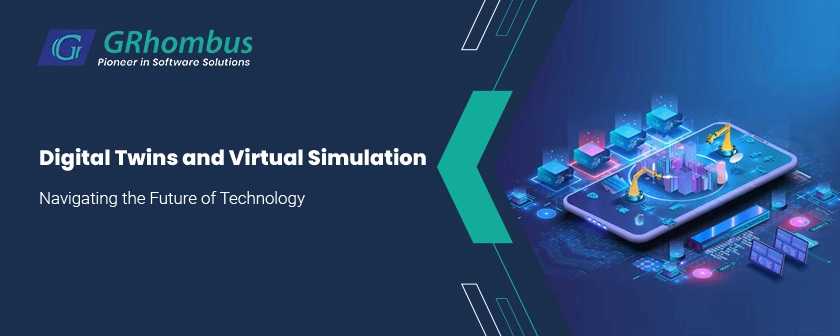In the realm of modern technology, digital twins and virtual simulations stand out as powerful tools transforming industries and businesses. While both concepts are pivotal in digital transformation, they serve distinct purposes and offer unique benefits. This blog explores the fundamentals of digital twins and virtual simulations, their real-world applications, and provides guidance on choosing the right option for your business.
Understanding Digital Twins
A digital twin is a virtual replica of a physical object, system, or process. It uses data from sensors, IoT devices, and other sources to mirror the real-world entity in real-time. This digital representation allows businesses to monitor, analyze, and optimize performance continuously.
Key Characteristics of Digital Twins:
- Real-Time Data Integration: Digital twins leverage real-time data from physical entities to provide an accurate virtual representation.
- Predictive Analytics: By analyzing data trends and simulations, digital twins can predict future conditions and performance.
- Continuous Monitoring: They enable ongoing monitoring and adjustment of the physical counterpart, enhancing operational efficiency and decision-making.
Real-World Applications of Digital Twins
Digital twins have diverse applications across various industries:
- Manufacturing: In manufacturing, digital twins are used to optimize production processes, monitor equipment health, and improve product design. For example, General Electric uses digital twins to simulate turbine performance and predict maintenance needs.
- Healthcare: Digital twins can create personalized models of patients for customized treatment plans and medical simulations. They help in improving patient outcomes by simulating responses to different treatments.
- Urban Planning: Cities use digital twins to manage infrastructure, plan developments, and optimize traffic flow. Singapore, for example, utilizes a digital twin to manage urban growth and improve city planning.
- Energy: In the energy sector, digital twins model power plants and grids to enhance efficiency, predict failures, and optimize resource management.
Delving into Simulation: An Introduction
Simulation involves creating a model of a system or process to study its behavior under various conditions. Unlike digital twins, simulations do not require real-time data but are instead based on predefined scenarios and theoretical models.
Key Characteristics of Simulations:
- Scenario-Based Testing: Simulations test how systems or processes perform under different conditions or scenarios.
- Predictive Modeling: They allow for the exploration of various “what-if” scenarios to predict outcomes and make informed decisions.
- No Real-Time Data Required: Simulations are based on theoretical models and assumptions rather than live data.
Practical Uses of Simulations in Business
Simulations are widely used across industries for a variety of purposes:
- Product Development: Companies use simulations to test and refine product designs before physical prototypes are created. For example, automotive manufacturers use crash simulations to enhance vehicle safety.
- Training and Education: Simulations provide a risk-free environment for training employees on complex systems or procedures. Airline pilots, for instance, use flight simulators to practice emergency scenarios.
- Supply Chain Management: Businesses simulate supply chain processes to optimize logistics, forecast demand, and improve inventory management.
- Financial Modeling: Simulations help financial institutions model market conditions, assess risk, and develop investment strategies.
Simulation vs. Digital Twin: What is the Difference?
While both digital twins and simulations involve modeling and analysis, they have distinct differences:
- Real-Time vs. Theoretical: Digital twins rely on real-time data from physical entities, while simulations are based on theoretical models and predefined scenarios.
- Continuous Monitoring vs. Scenario Testing: Digital twins provide ongoing monitoring and adjustment, whereas simulations explore various hypothetical scenarios without continuous data integration.
- Application Focus: Digital twins are used for real-time optimization and performance monitoring of physical systems. In contrast, simulations are used for theoretical analysis, training, and scenario testing.
Choosing the Right Option for Your Business: Digital Twin vs. Simulation
Deciding between digital twins and simulations depends on your business needs and objectives. Here’s a guide to help you choose:
When to Choose a Digital Twin:
- Real-Time Monitoring: If your business requires real-time performance monitoring and continuous optimization, digital twins are ideal.
- Complex Systems: For complex systems where live data is critical for accurate analysis, digital twins offer a more comprehensive solution.
- Predictive Maintenance: If you need to predict equipment failures or optimize operational efficiency based on real-time data, digital twins are beneficial.
When to Choose Simulation:
- Scenario Analysis: If you need to explore various “what-if” scenarios or test theoretical models, simulations are suitable.
- Training and Education: For creating training programs or educational tools without real-world risks, simulations are effective.
- Product Design: When refining product designs or testing prototypes in a controlled environment, simulations provide valuable insights.
Evaluating Your Business Needs: When to Choose What?
- Assess Objectives: Determine whether your primary need is real-time monitoring and optimization (digital twins) or theoretical scenario analysis (simulations).
- Consider Data Requirements: If continuous data integration is crucial, digital twins are the way to go. If you’re focusing on hypothetical scenarios, simulations may suffice.
- Evaluate Complexity: For complex systems with intricate interdependencies, digital twins offer real-time insights. For simpler models or training purposes, simulations are more appropriate.
- Resource Availability: Consider the resources required for implementation. Digital twins may require more sophisticated data infrastructure, while simulations can often be implemented with existing modeling tools.
Conclusion
Both digital twins and virtual simulations are transformative technologies with distinct applications and benefits. Digital twins offer real-time insights and optimization for complex systems, while simulations provide valuable scenario testing and theoretical analysis. Understanding the differences and evaluating your business needs will help you choose the right approach to drive innovation, improve efficiency, and enhance decision-making in your organization. Embracing these technologies can position your business for success in an increasingly digital and data-driven world.
